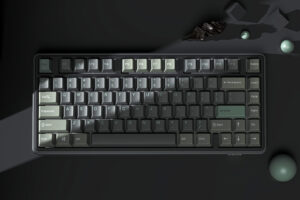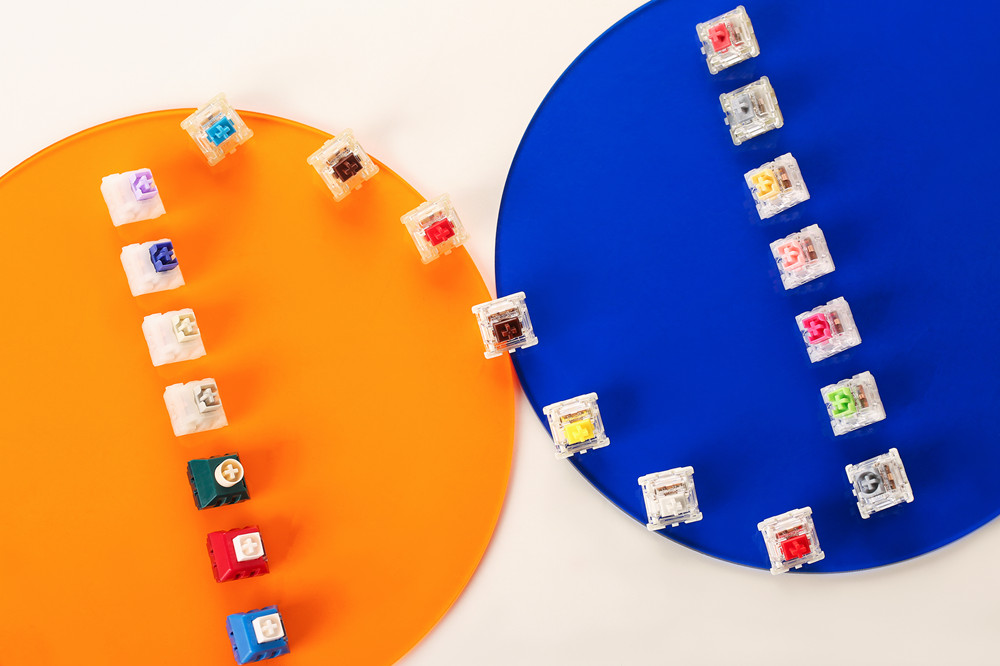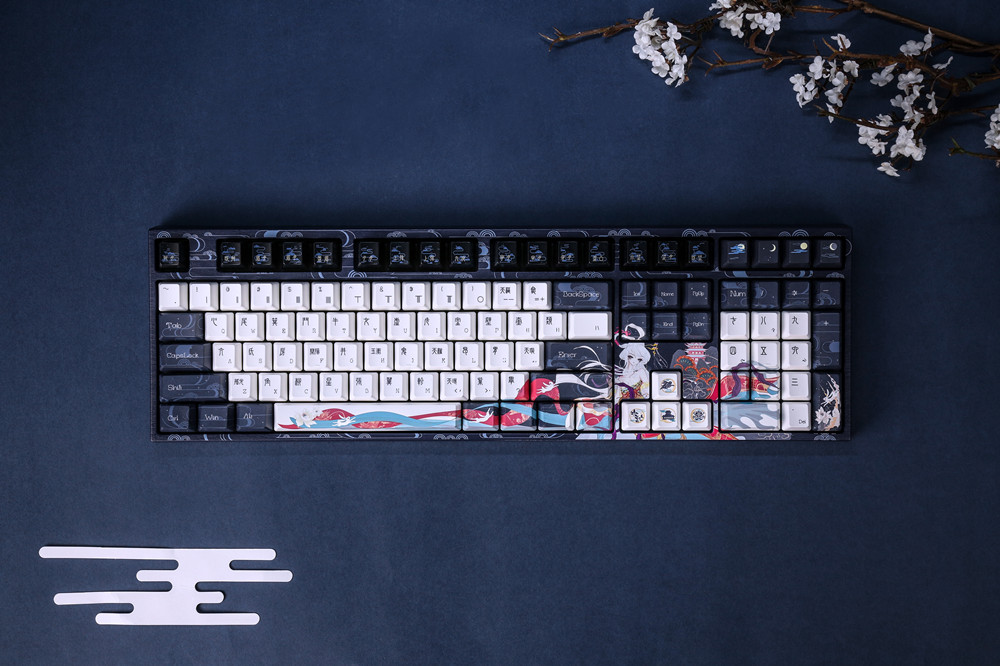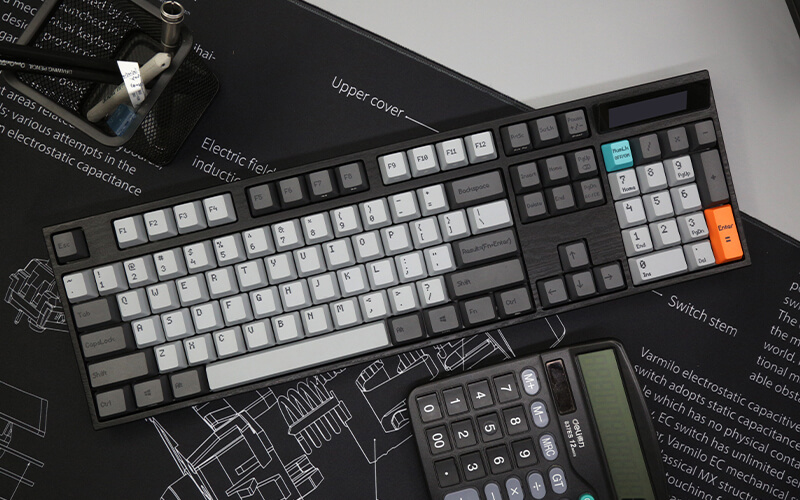Beneath the keys on every keyboard are the switches. Like regular switches, they work by pressing a key to complete a circuit and actuate it. There are various designs and implementations of this principle. Keyboard switches can be categorized into mechanical switches and membrane switches.
You will find mechanical switches neatly tucked beneath the keys of a mechanical keyboard. These switches contain moving parts, and they differ significantly from other switches.
Mechanical keyboard Terminology.
Here are some terms used in mechanical keyboards and their meanings for clarity.
- Actuation force: This is the amount of force you need to depress a key and actuate it. It is measured in gram-force or centinewtons. The conversion of gram-force to newton is approximately the same. It determines how light or heavy the switch.
- Actuation point: The actuation point is the point during key travel that the key registers or actuates.
- Bottoming out: When you bottom out, you fully depress a key switch. Mechanical switches do not need to be bottomed out before the actuate a key, unlike rubber dome keyboards. This makes mechanical keyboards faster than membrane keyboards.
- Ghosting: Ghosting occurs when unintended keys are registered on a keyboard. It happens when the keyboard can no longer actuate a set of keys pressed at the same time. The keys that do not show up are said to be ghosted.
- Keycap: The keycap is the plastic top attached to a switch. This is what your fingers make contact with. Letters and symbols are also printed on the keycap.
- Key rollover: The key rollover is the maximum amount of keys a keyboard can register when pressed together. For instance, a keyboard that can register ten keys at a time has a 10-key rollover.
- Key travel: The key travel distance is the distance a key can travel until it bottoms out. This distance is measured in millimeters.
- Reset point: The reset point is the distance the switch needs to travel before it resets and can accommodate another keypress.
- Terminal force: The terminal force it the amount of force exerted by the switch.
Parts of a mechanical switch.
The mechanical switch comprises the following parts.
- Keycap: It is the plastic top of the mechanical switch. It sits above the stem, and all the alphanumeric keys are printed on it. Keycaps are mostly made of plastic.
- Switch housing: As the name suggests, the switch housing holds the switch together.
- Slider: The slider guides the stem while it moves.
- Stem: The stem is connected to the switch and transforms the downward force of your fingers into motion. The shape of the stem also determines the type of keycap to be used.
- Spring: It returns the stem and the keycap to its initial position after a keypress. The spring also determines the tension and the actuation force on a key. The stiffer a spring, the more force is needed to actuate a key.
- Metal contact leaves: The metal contact leaves are responsible for actuating a key. Their design may differ slightly in different switches, but they serve the same function. With the aid of the slider and the stem, these contact leaves touch and complete a circuit.
This completed circuit registers the input signal, and the key is registered. Although most traditional mechanical switches use metal contact leaves, not all of them require physical contact to work.
Mechanical keyboard switch accessories
- O-rings: O-rings are plastic rings that dampen the sound mechanical switches make. These rings are placed beneath the keycap. Depending on the thickness, O-rings can significantly reduce the travel distance on the switches. O-rings come in different sizes and thicknesses. The one you choose should be compatible with your keycaps and switches.
- Keycap-switch puller: The function of the keycap puller is as simple as it sounds: to remove the keycaps and the switches on the keyboard. It has specialized tongs on one end for the keycaps and another set of tongs for the switches.
Types of mechanical switches.
The main thing that affects the keyboard typing feels is the switches. Beyond that, other things affect typing feels in a switch. We will discuss that later. Switches can be broadly grouped into three categories.
Linear mechanical switches.
Linear switches give the smoothest feedback of all switches. They provide uniform resistance when you press down on them. Linear switches, like all switches, can be heavy or light depending on the actuation force. Because of how smooth they are and how easy it is to press a key repeatedly, linear switches are popular among gamers.
Good examples of linear switches are the Cherry MX Red switch, the Varmilo EC Daisy.
Varmilo’s EC Daisy is a light switch with an actuation force of only 35 grams. The terminal force is 45g. It is much lighter than the Cherry MX Red and Speed sliver switches. Its actuation point is 2mm.
Clicky mechanical switches.
Clicky switches have made mechanical keyboards infamous. Mechanical keyboards with clicky switches give off a click sound when you actuate a key. Their characteristic click or clack noise is quite indispensable for some keyboard users.
They are highly sought after by people who love to type. If you love audio feedback while you type, you should get a keyboard with clicky switches. Examples of clicky switches are the Cherry MX Blue and the Varmilo EC Ivy switch.
The EC ivy switch has a tactile force of 60g and an actuation force of 50g. It actuates at 2.4mm and has a full key travel of 4mm. Its terminal force is 65g.
Tactile mechanical switches.
Tactile switches are for users who love the feedback but do not want the noise. These switches produce subtler feedback than clicky switches. When you press down on a tactile switch, you will experience a bumpy feel during the travel.
This makes them great for typing and gaming. You do not have to bottom out a key before registers. It can also increase your typing speed. Prime example of tactile mechanical switches is the Cherry MX Brown.
How does a mechanical switch work?
When a finger presses down on a key, the stem moves and the slider guides it downward. The slider pushes down and allows the metal leaves in the switch to make contact. When these metals leaves make contact, a circuit is completed, and the key is registered. The spring then returns the stem to its original position.
Other forms of mechanical switches.
As humankind advances in knowledge, technology evolves. It shouldn’t be much of a surprise that the mechanical switch has also evolved in many ways. There are mechanical switches that do not use the traditional method of registering keys.
These new designs work on the limitations of traditional mechanical keyboards and make them better. You should know that these switches still have mechanical parts like the spring, stem, and others. They are by no means substandard mechanical switches. They have better features that make them stand out. Some of these new technologies are the optical, mechanical switch, and the electrostatic capacitive mechanical switch.
Electrostatic Capacitive mechanical switches.
Electrostatic capacitive switches work with the principle of electrostatic capacitance. Instead of physical contact to complete a circuit and register a key, the switch measures a change in the capacitance between the two metal leaves. The capacitance between the two metal leaves varies directly with distance.
This makes them last longer than traditional mechanical keyboards. EC mechanical switches do not suffer from input lag, so they have higher response times than most traditional switches. In theory, these switches have a limitless lifespan. You also get the same satisfactory typing feels as you would get from a conventional keyboard.
Optical mechanical switches.
Just like the EC mentioned above, the Optical mechanical switch has a contactless mode of operation. As you may have guessed, the optical mechanical keyboard uses light to actuate a key. Keyboards with optical switches also promise faster response times than traditional switches.
Currently, optical switches work in two ways. The first method uses a horizontal beam of infrared light under the switch shaft. The stem in the switch blocks the light from passing through. A keypress moves the stem out of the pathway of the light, a sensor receives this light, and the key is actuated.
The other method is quite different from the first. Most of the components needed to actuate a key is on the printed circuit board. Each switch has an IR sensor beneath it.
This sensor uses Infrared Photometric Radiothermal (IR PTR) technology to detect a keypress. It actuates a key when the switch is sufficiently close to the sensor. Because of this design, the keyboard is very modular. You can swap the switches easily.
Optical mechanical switches do not have input lag issues, and they are faster than traditional switches.
What affects the typing feels of mechanical switches.
Contrary to what people think, typing feels do not solely depend on the type of mechanical switches your keyboards come with. Typing feels are affected by many other factors. These factors also determine the quality of a mechanical keyboard.
Wobbliness.
No one likes wobbly keys. No matter how good the switches underneath the keys are, they won’t give good typing feels. Mechanical keyboards with wobble keys look cheap, and the durability would be called into question. For the best feels and feedback, the keys need to be firm and robust.
Smoothness.
The feeling you get when you press down on a key varies, even among switches in the same category. This feeling depends on how smooth the switch is. Smoothness can be defined by the amount of friction the finger feels when it pressed down on a key. This feature shines the most in linear switches. They are designed to be smooth, so they give uniform resistance when you press down on them.
Consistency.
Mechanical switches last tens of millions of keypresses. For the best typing feels, the keys should produce consistent feedback until they peg out. Many professionals and gamers spend hours on their computers. A good keyboard should offer premium and reliable feels at all times.
Not only should the keys be consistent throughout their lifespan, but they should also be consistent from different angles. This can be easily overlooked.
Spring resonance and noise.
Spring noise on mechanical keyboards can be very annoying, especially when the keys are pressed rapidly. This can also cause a scrappy noise in a keyboard. Low-quality springs can make the keys wobble more than they should. These things will indeed affect the quality of feedback you get from a mechanical switch.
Sound.
One of the most discussed qualities of the mechanical keyboard is the sound. Some love it, and others love to hate it. It not only helps to give confirmatory feedback much needed in typing but also improves speed and prevents ghosting. It is not just about having a clicky or clacky sound. But has to be clean and crisp.
Mechanical switch mounting.
The Printed circuit board(PCB) is a thin board that contains all the conductive traces (or circuit pathways) on it. The components on the keyboard including the controllers and the LEDs are soldered directly on it. A controller is the brain of the keyboard. It analyses the input from the keyboard and sends it to the computer.
Mechanical keyboards with plate mounted switches use a metal plate to arrange the switches before being mounted on the circuit board. PCB mounted switches are directly mounted to the circuit board. They have guide pins to help put them in place properly. Mechanical keyboards with a plate mounted switches are weightier than regular mechanical keyboards. This gives them more robustness than those mounted directly to the circuit board.
Why should you go for mechanical switches?
Why should you buy a mechanical keyboard? What makes them so unique? We will highlight all the features that make mechanical keyboards great. Mechanical switches are worth the hype and more. All comparisons here will be referring to membrane keyboards.
Durability.
Mechanical keyboards switches are very durable and last for a long time. Most mechanical switches are built to endure more than 30-50 million switches. Some premium quality switches can last up to 100 million presses. With the advent of mechanical switches that utilize new technologies, these numbers have gone up.
For instance, the Electrostatic capacitive mechanical switch lasts much longer than even premium mechanical switches. On the other hand, most non-mechanical switches last about 3-6 million presses. The difference in keypresses compared to other non-mechanical switches means many more years of useful life.
Speed and Response times.
Mechanical switches are much faster than rubber dome switches found in membrane keyboards. Mechanical switches take, on average, 6 ms to register a key. Other mechanical switches like the EC mechanical switch and the optical switch take less time to actuate keys.
Typing feels.
Mechanical switches give unique and unmistakable typing feels. If you haven’t used a mechanical keyboard before, the experience of using one for the first time will blow you away. The feel is significantly different from the mushy feel of a membrane keyboard. The type of switch(es) present on a mechanical keyboard will determine the typing feel.
Typing feels are generally grouped into three- linear, clicky, and tactile. Although these are the feels you should expect from a keyboard, the quality of those feels depends on the manufacturer. Nonetheless, the feels beat that of a membrane keyboard any day, any time.
Sturdiness.
Mechanical keyboards are very sturdy. Their extra weight grounds them properly on any surface they are placed on. Plate mounted switches also add to the weight and increases the sturdiness. They won’t wobble while typing or gaming.
Ease of cleaning.
Mechanical Keyboards are easy to clean and maintain. The keycaps can easily be removed with a keycap puller for easy cleaning. With more enthusiasm, the switches can be removed and cleaned. Mechanical keyboards also handle spills better than membrane keyboards. Simply turning them over and leaving to dry should suffice for simple spills.
Key rollover.
Mechanical keyboards have more key rollovers than other keyboards. Most non-mechanical keyboards allow for a 10-key rollover. With mechanical switches on mechanical keyboards, you can get a full key rollover.
Customization and modularity.
The design of the switch and keycaps on mechanical keyboards allow for easy customization. Keycaps are quite easy to replace. You can achieve colorful layouts and designs with different keycaps. Manufacturers such as Varmilo produce beautiful themed EC mechanical keyboards with alluring designs.
Not only can you change the keycaps on a mechanical keyboard but also the switches. Keyboards that allow for this kind of customization are called hot-swappable keyboards. The switches can be changed without needing to unsolder them from the PCB. You can change specific switches to give you an edge. You could change the WSAD or other keys on a keyboard for a better gaming experience. Membrane keyboards do not offer this level of modularity.
Mechanical switches are easier to fix than membrane keyboards. They last longer, and the chance of them developing faults is less. You won’t find as many mechanical keyboards in the garbage as membrane keyboards.
How to choose the right mechanical switch?
Choosing the right mechanical switch depends on a few things. They include your lifestyle/general-purpose, your typing preferences, your hand size, and strength.
Lifestyle and general-purpose.
If you use your keyboards for a good portion of a day, you will need one that will make your work as comfortable as it can be. Some mechanical keyboard switches suit different lifestyles.
Light switches can reduce stress while typing and can also help prevent tenosynovitis. Linear switches are good for gaming too. For those who love feedback during use, tactile and clicky switches are the way to go.
Typing preference.
Depending on your job and hobbies, you will spend a good amount of time on your computer typing. For those who type often, a good keyboard will maximize your performance and comfort. Like you already know, different switches give different feedback.
Linear switches offer a good, and smooth typing feel with little tactile or audio feedback. This is a good choice if your environment dictates it. For unbeatable feedback during typing, you should go for tactile or clicky switches.
Environment.
Clicky switches are quite loud. Having the sound is good too. If you want to get clicky switches, you should consider your work environment. If you are in an environment where others can deal with the sound, then you are good to go.
You may be causing a bit of a nuisance to others with the loud unending clicks. Imagine being surrounded by people who are constantly typing on their clicky keyboards. The noise will be annoying, to say the least. No one wants an annoying co-worker.
Hand size and strength.
Believe it or not, the size and strength of your fingers will affect the way you type. People with big fingers tend to misclick on their keyboards. To avoid misclicks, you should go for switches that are medium to heavy and have a higher actuation point.
It would take a little more effort to click on keys, but this would avoid the misclicks. Tactile switches are generally in this category.
If you have gentler hands, then having light to medium switches with low activation points would do just fine.
Varmilo EC Mechanical Keyboards.
If you are looking for a premium mechanical keyboard, then look no further. The Varmilo EC mechanical keyboard uses Electrostatic Capacitance in their switches. They are faster and more sensitive. They outshine traditional mechanical keyboards in life, and they offer all the premium feels you expect from one. Click here for more info.
Every keyboard in their themed collection is a masterpiece. These keyboards have elegant designs and beautiful colors.









